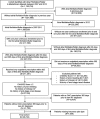Association of Healthcare Plan with atrial fibrillation prescription patterns
- PMID: 30098034
- PMCID: PMC6489790
- DOI: 10.1002/clc.23042
Association of Healthcare Plan with atrial fibrillation prescription patterns
Abstract
Background: Atrial fibrillation (AF) is treated by many types of physician specialists, including primary care physicians (PCPs). Health plans have different policies for how patients encounter these providers, and these may affect selection of AF treatment strategy.
Hypothesis: We hypothesized that healthcare plans with PCP-gatekeeping to specialist access may be associated with different pharmacologic treatments for AF.
Methods: We performed a retrospective cohort study using a commercial pharmaceutical claims database. We utilized logistic regression models to compare odds of prescription of oral anticoagulant (OAC), non-vitamin K-dependent oral anticoagulant (NOAC), rate control, and rhythm control medications used to treat AF between patients with PCP-gated healthcare plans (eg, HMO, EPO, POS) and patients with non-PCP-gated healthcare plans (eg, PPO, CHDP, HDHP, comprehensive) between 2007 and 2012. We also calculated median time to receipt of therapy within 90 days of index AF diagnosis.
Results: We found similar odds of OAC prescription at 90 days following new AF diagnosis in patients with PCP-gated plans compared to those with non-PCP-gated plans (OR: OAC 1.01, P = 0.84; warfarin 1.05, P = 0.08). Relative odds were similar for rate control (1.17, P < 0.01) and rhythm control agents (0.93, P = 0.03). However, PCP-gated plan patients had slightly lower likelihood of being prescribed NOACs (0.82, P = 0.001) than non-gated plan patients. Elapsed time until receipt of medication was similar between PCP-gated and non-gated groups across drug classes.
Conclusions: Pharmaceutical claims data do not suggest that PCP-gatekeeping by healthcare plans is a structural barrier to AF therapy, although it was associated with lower use of NOACs.
Keywords: arrhythmia/all; atrial fibrillation; socio-economic aspects; thrombosis/hypercoagulable states.
© 2018 Wiley Periodicals, Inc.
Conflict of interest statement
Andrew Young Chang: None; Mariam Askari: None; Jun Fan: None; Paul A. Heidenreich: None; P. Michael Ho: Janssen Pharmaceuticals, American Heart Association; Kenneth W. Mahaffey: Ablynx, Afferent, Amgen, AstraZeneca, BAROnova, Bio2 Medical, BioPrint Fitness, Boehringer Ingelheim, Bristol Myers Squibb, Cardiometabolic Health Congress, Cubist, Daiichi, Eli Lilly, Elsevier, Epson, Ferring, Glaxo Smith Kline, Google (Verily), Johnson & Johnson, Medtronic Inc., Merck, Mt. Sinai, Myokardia, Novartis, Oculeve, Portola, Radiomeer, Sanofi, Springer Publishing, St Jude Medical, The Medicine Company, Theravance, UCSF, Vindico, WebMD; Aditya Jathin Ullal: None; Alexander Carroll Perino: None; Mintu P. Turakhia: Janssen Pharmaceuticals, Medtronic Inc., AztraZeneca, Veterans Health Administration, AliveCor, St. Jude Medical, Boehringer Ingelheim, Precision Health Economics, Zipline Medical, iBeat Inc., Akebia, Cardiva Medical, Medscape/
Figures
Similar articles
-
Prescription Patterns of Non-Vitamin K Oral Anticoagulants Across Indications and Factors Associated with Their Increased Prescribing in Atrial Fibrillation Between 2012-2015: A Study from the Norwegian Prescription Database.Drugs Aging. 2017 Aug;34(8):635-645. doi: 10.1007/s40266-017-0476-4. Drugs Aging. 2017. PMID: 28710707
-
Racial Disparity in the Prescription of Anticoagulants and Risk of Stroke and Bleeding in Atrial Fibrillation Patients.J Stroke Cerebrovasc Dis. 2020 May;29(5):104718. doi: 10.1016/j.jstrokecerebrovasdis.2020.104718. Epub 2020 Feb 28. J Stroke Cerebrovasc Dis. 2020. PMID: 32122777
-
Association of insurance type with receipt of oral anticoagulation in insured patients with atrial fibrillation: A report from the American College of Cardiology NCDR PINNACLE registry.Am Heart J. 2018 Jan;195:50-59. doi: 10.1016/j.ahj.2017.08.010. Epub 2017 Aug 31. Am Heart J. 2018. PMID: 29224646
-
Appropriate doses of non-vitamin K antagonist oral anticoagulants in high-risk subgroups with atrial fibrillation: Systematic review and meta-analysis.J Cardiol. 2018 Oct;72(4):284-291. doi: 10.1016/j.jjcc.2018.03.009. Epub 2018 Apr 26. J Cardiol. 2018. PMID: 29706404
-
Non-vitamin K antagonist oral anticoagulants in atrial fibrillation accompanying mitral stenosis: the concept for a trial.Europace. 2016 Jan;18(1):6-11. doi: 10.1093/europace/euv288. Epub 2015 Oct 7. Europace. 2016. PMID: 26450845 Review.
Cited by
-
Duration of Nucleos(t)ide Analogue Treatments in Patients With Chronic Hepatitis B Virus Infection in the United States.J Viral Hepat. 2025 Aug;32(8):e70055. doi: 10.1111/jvh.70055. J Viral Hepat. 2025. PMID: 40667578 Free PMC article.
-
Factors associated with oral anticoagulant prescription status among patients with a new diagnosis of atrial fibrillation.Clin Cardiol. 2023 Aug;46(8):937-941. doi: 10.1002/clc.24077. Epub 2023 Jul 4. Clin Cardiol. 2023. PMID: 37401357 Free PMC article.
-
Sex Differences in Oral Anticoagulation and Outcomes of Stroke and Intracranial Bleeding in Newly Diagnosed Atrial Fibrillation.J Am Heart Assoc. 2020 May 18;9(10):e015689. doi: 10.1161/JAHA.120.015689. Epub 2020 May 12. J Am Heart Assoc. 2020. PMID: 32394763 Free PMC article.
References
-
- Turakhia MP, Hoang DD, Xu X, et al. Differences and trends in stroke prevention anticoagulation in primary care vs cardiology specialty management of new atrial fibrillation: The Retrospective Evaluation and Assessment of Therapies in AF (TREAT‐AF) study. Am Heart J. 2013;165((1)):93‐101.e1. 10.1016/j.ahj.2012.10.010. - DOI - PubMed
Publication types
MeSH terms
Substances
Grants and funding
LinkOut - more resources
Full Text Sources
Other Literature Sources
Medical
Research Materials


